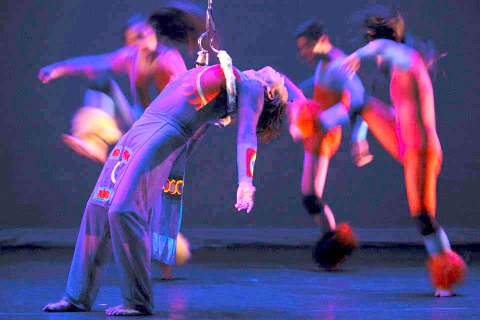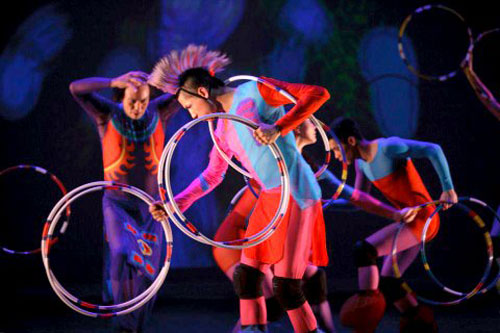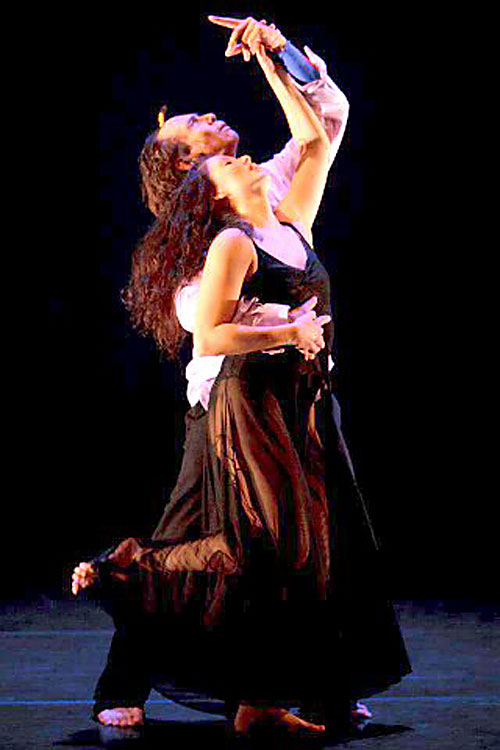|
Across native North America (Canada and the United States), I have watched a number of Indigenous contemporary dance companies struggle into existence over the last twenty years. A few of those have managed to emerge, with grit and determination, into world class status. One of those is Kaha:wi Dance Theatre. The company work began in 2001, but official recognition was established in 2004 with the premiere at Harbourfront Centre, Toronto, of the company's first large work titled "Kaha:wi".
Santee Smith, Kaha:wi Dance Theatre founder and artistic director is Mohawk (Turtle Clan) and lives at Six Nations of the Grand River in Ontario. Kaha:wi (ga-HAH-wee) means "to carry" and this is exactly what she has done – carrying forward to the wider world an expression of Indigenous belief, sensibility, stories both ancient and new. She has said: "My work is a response and a reflection of the world in which I live. Through dance I am able to express my dreams, vision and stories both historical and contemporary". Santee Smith has steadily created and produced notable choreography over the last seven years: Here On Earth (2005), The Threshing Floor (co-choreography, 2006) , A Constellation of Bones (2007), A Story Before Time (2007), A Soldier's Tale (2008), The Creator's Game (2011), Medicine Bear (2011).
Kaha:wi-based choreography is always earthy, vigorous, tightly-woven and highly physical. On May 10th of this year, however, with the premiere of her new work TransMigration, Santee Smith has entered a bolder, broader, and intensely dramatic theatrical world. Undertaking the subject of the work - the art and spiritual/physical life of Norval Morriseau – would require entering that extreme world in which he lived.
Norval Morrisseau, Ojibway artist who literally passed into the spirit world in 2007, was dubbed the "Picasso of the North " by Marc Chagall. How does one begin to talk about Norval Morrisseau? His personal and artistic life overwhelms the senses; a man and an artist of extremes: genius, visionary shaman, drunk, depressive, a man wheelchair-bound. He experienced the horrors of the residential boarding school, the ongoing demons of alcohol, and finally the progressive ravages of Parkinson's disease. He had gone to the lowest pits of mortal life. But he also rose to the soaring heights of the shaman's world, in large part as a result of being raised by his grandfather, a tradition to foster adherence to the old ways of the culture. At age 19, Morrisseau came down with an illness that western medicine failed to cure. His mother summoned a medicine woman who performed a ceremony, giving him a new name: Copper Thunderbird. Morrisseau recovered; at his wife's hand he learned the Cree syllabic alphabet. All future paintings were signed in that language as Copper Thunderbird. Apparently Morrisseau painted at a fever pitch, often creating several paintings at once. One of his most memorable painting series are six panels titled "Man into Thunderbird", a visual interpretation of his own transformation from physical man into spiritual Thunderbird. This series of paintings, along with others became a major inspiration for Santee Smith's extreme journey that has become the full evening work TransMigration.
 |
Artist's Wife and Daughter 1975 - Norval Morrisseau
In an after-show talk, the choreographer revealed that she had begun gestating the work as long ago as 2006. And no wonder – the work is large in every sense: costume colors as bold as used by Morriseau in his paintings, large in designs projected on the upstage cyclorama and painted on the floor, large in music (nine different musicians are credited), large in variegated movement styles from traditional Haundenosaunee steps to the plains hoop dance to full-out western modern dance idioms.
 |
And no element was larger or more finely tuned than the performance by Raoul Trujillo as "the artist". Mr. Trujillo is well-known in the professional world, having performed with the Nikolais Dance Theatre as a soloist and principal dancer and as guest artist with many companies throughout North America. He was the celebrated host for the "Dance in America" television series and starred in such films as "Black Robe" (Canada) and "Apocalypto" (USA). Seeing the premiere in Toronto, I was struck by how perfectly suited Raoul Trujillo is to this role. It was a seminal role for him, as an actor, a dancer, an interpreter of artistic temperament at an age that he can intellectually and emotionally embody such a man as Norval Morrisseau. Trujillo was onstage almost continually, entering, exiting, crossing in a drunken stupor right to left, weaving in and out of the seven-member cast who portrayed at will residential school students, figures in black, myriad birds, animals, and "astral" creatures, now center stage being photographed by admiring crowds, under a table drawing in out-of-control madness, then enveloping his wife with the same physical fervor with which he painted his in-the-air visions that would later appear on birchbark, brown paper, masonite and finally canvas.
 |
The aural landscape floated by in supportive relevance to the scene being performed, so adapted in fact that at the end of the night I could not recall the music, so perfectly did it coalesce with the onstage action. The visual elements remain with me: the opening scene with a stage full of nighttime stars and only "the artist" sitting center stage, a large bold cross, empty-looking until a red ooze began to fill the cross as if in blood, a grey urban-scape of the city pierced through with ancient pictographs (a Morrisseau painting motif). Other painterly aspects were used, but not one of Morrisseau's actual paintings, now held hostage by family feuding over copyright issues. Instead, Santee Smith provided original paintings created by her, assisted by Semiah Smith and Jenny So, projected on the cyclorama and in a floor painting laid down by the crew during the intermission.
Of equal importance were stand-out performances by Arik Pipestem, Michael Caldwell and Mami Hata. Ms Hata, a native of Japan, was given the role as the sacred Thunderbird. She is a consummate performer, able to do anything. Casting the Thunderbird in a female dancer was an interesting choice. We think of the Thunderbird as male, but presenting it in female form seemed to accentuate the nurturing qualities so necessary to "the artist's" reclamation of himself in physical and spiritual form. Michael Caldwell is an intense dynamo on stage, an excellent choice for the younger Morrisseau.
 |
What can be said about Arik Pipestem that has not been already said? Arik is a First Nations dancer and choreographer who has made his mark in such venues as Cirque Du Soleil: Totem. To his special credit, he has originated a new form of hoop dance he calls "X-D-T": Extraordinary Hoop Technique. And that is what he presented in TransMigration: extraordinary technique with a few number of hoops, dancing with speed that I have never seen before in this dance form, a vision of pure unbridled joy in dance.
Santee Smith took a small but important role as "the artist's" wife, completing the picture of Morrisseau as a family man as well as shamanic initiate. The program credits her as Artistic Director, Choreographer, Designer and Interpreter. She lists the dancers as "Interpreters", another interesting choice, confirming the performer's actual business not only to move and dance, but to embody and translate the meaning of the choreography to the audience. In this production, Ms. Smith has allowed her practice as a visual artist (she is a painter and potter) to be an integral component of the work.
 |
TransMigration is a work about an artist who lived to the extreme limits of physical and spiritual reality. In order to meet that challenge, Santee Smith permitted herself to break the bounds of her "old" work thus far realized, into authentic storytelling and its emotional counterparts. The challenge is there in how to handle phrasing and the timing of dramatic action. In this work, there are moments and whole sections of brilliance and amazing invention. In other instances, there were difficulties. The scene closing the first act runs much too long; the dramatic point of Morrisseau's excesses is made over and over again until the impact wears thin. The descent of a giant hoop from the fly space was abrupt, perhaps even fumbled: a good stage prop needs impeccable timing in its execution. Sitting in the third row of Fleck Theatre at Harbourfront Centre gave no aesthetic distance and perhaps for that reason, the final moments of the final scene with dancers painting themselves seemed overdone.
Santee Smith is a totally professional Indigenous choreographer at work in her own time. She is making a significant contribution to the development of contemporary Indigenous dance in North America. And as if to tell us all that "you haven't seen nothin' yet!", she has another premiere coming up in August, 2012, presented as part of the Planet IndigenUs in Toronto. "Susuriwka – Willow Bridge" was developed in collaboration with selected Japanese artists and the Ainu Indigenous peoples of that country and will feature visiting Japanese dance and musical artists. Also this summer she will tour "Medicine Bear" to Alberta, British Columbia and Saskatchewan in conjunction with the International Children's Festival in Vancouver. And if that weren't enough, Santee Smith again hosts the Aboriginal Training Program housed at the National Ballet of Canada, Toronto August 9-31; the program is the only one of its kind in North America, combining classical and Indigenous dance training in one coordinated curriculum.
Indigenous artists have been doing extraordinary cultural and fine arts work for more than a century, but it was not until 2005 that such an artist was granted an exhibition at the National Gallery of Canada, Ottawa. That artist was Norval Morrisseau, and it occurred two years before his death. This is a disgraceful record for the NGC. Santee Smith pushed for the premiere of TransMigration to mark the 50th anniversary of Norval's first exhibition at the Pollock Gallery in Toronto, 1962. A chance to see the original paintings will be September 15-October 20 when the Kinsman Robinson Galleries mount A Norval Morrisseau Retrospective 2012. In the meantime, I strongly encourage everyone to look at his paintings at the Coghlan Arts Gallery at coglanart.com. You can see the six panel "Man into Thunderbird" as a link from that site, or at morrisseauprints.com. Information on Santee Smith can be found at kahawidance.org.
Photos - David Hou
|



